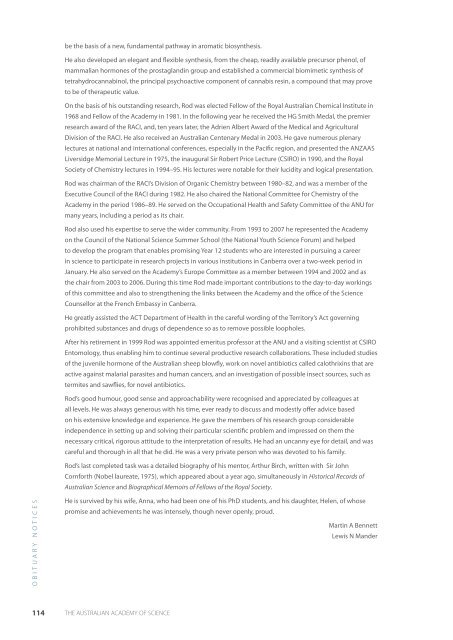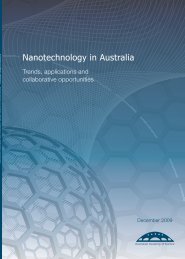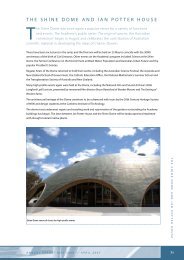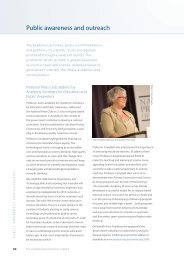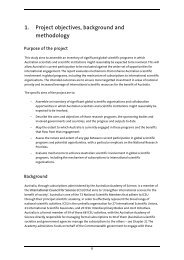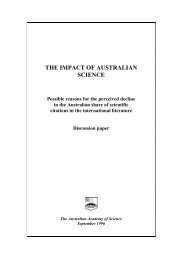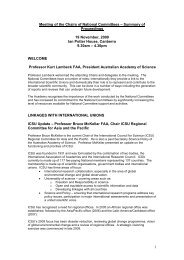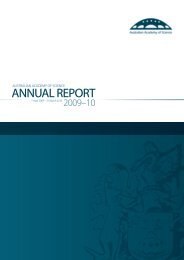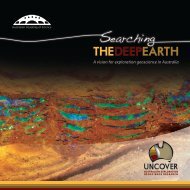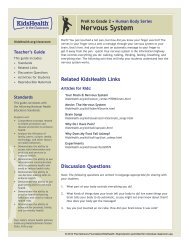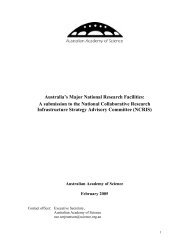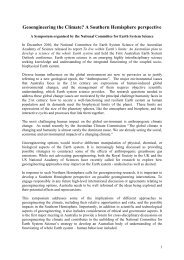full report - Australian Academy of Science
full report - Australian Academy of Science
full report - Australian Academy of Science
You also want an ePaper? Increase the reach of your titles
YUMPU automatically turns print PDFs into web optimized ePapers that Google loves.
e the basis <strong>of</strong> a new, fundamental pathway in aromatic biosynthesis.<br />
He also developed an elegant and flexible synthesis, from the cheap, readily available precursor phenol, <strong>of</strong><br />
mammalian hormones <strong>of</strong> the prostaglandin group and established a commercial biomimetic synthesis <strong>of</strong><br />
tetrahydrocannabinol, the principal psychoactive component <strong>of</strong> cannabis resin, a compound that may prove<br />
to be <strong>of</strong> therapeutic value.<br />
On the basis <strong>of</strong> his outstanding research, Rod was elected Fellow <strong>of</strong> the Royal <strong>Australian</strong> Chemical Institute in<br />
1968 and Fellow <strong>of</strong> the <strong>Academy</strong> in 1981. In the following year he received the HG Smith Medal, the premier<br />
research award <strong>of</strong> the RACI, and, ten years later, the Adrien Albert Award <strong>of</strong> the Medical and Agricultural<br />
Division <strong>of</strong> the RACI. He also received an <strong>Australian</strong> Centenary Medal in 2003. He gave numerous plenary<br />
lectures at national and international conferences, especially in the Pacific region, and presented the ANZAAS<br />
Liversidge Memorial Lecture in 1975, the inaugural Sir Robert Price Lecture (CSIRO) in 1990, and the Royal<br />
Society <strong>of</strong> Chemistry lectures in 1994–95. His lectures were notable for their lucidity and logical presentation.<br />
Rod was chairman <strong>of</strong> the RACI’s Division <strong>of</strong> Organic Chemistry between 1980–82, and was a member <strong>of</strong> the<br />
Executive Council <strong>of</strong> the RACI during 1982. He also chaired the National Committee for Chemistry <strong>of</strong> the<br />
<strong>Academy</strong> in the period 1986–89. He served on the Occupational Health and Safety Committee <strong>of</strong> the ANU for<br />
many years, including a period as its chair.<br />
Rod also used his expertise to serve the wider community. From 1993 to 2007 he represented the <strong>Academy</strong><br />
on the Council <strong>of</strong> the National <strong>Science</strong> Summer School (the National Youth <strong>Science</strong> Forum) and helped<br />
to develop the program that enables promising Year 12 students who are interested in pursuing a career<br />
in science to participate in research projects in various institutions in Canberra over a two-week period in<br />
January. He also served on the <strong>Academy</strong>’s Europe Committee as a member between 1994 and 2002 and as<br />
the chair from 2003 to 2006. During this time Rod made important contributions to the day-to-day workings<br />
<strong>of</strong> this committee and also to strengthening the links between the <strong>Academy</strong> and the <strong>of</strong>fice <strong>of</strong> the <strong>Science</strong><br />
Counsellor at the French Embassy in Canberra.<br />
He greatly assisted the ACT Department <strong>of</strong> Health in the careful wording <strong>of</strong> the Territory’s Act governing<br />
prohibited substances and drugs <strong>of</strong> dependence so as to remove possible loopholes.<br />
After his retirement in 1999 Rod was appointed emeritus pr<strong>of</strong>essor at the ANU and a visiting scientist at CSIRO<br />
Entomology, thus enabling him to continue several productive research collaborations. These included studies<br />
<strong>of</strong> the juvenile hormone <strong>of</strong> the <strong>Australian</strong> sheep blowfly, work on novel antibiotics called calothrixins that are<br />
active against malarial parasites and human cancers, and an investigation <strong>of</strong> possible insect sources, such as<br />
termites and sawflies, for novel antibiotics.<br />
Rod’s good humour, good sense and approachability were recognised and appreciated by colleagues at<br />
all levels. He was always generous with his time, ever ready to discuss and modestly <strong>of</strong>fer advice based<br />
on his extensive knowledge and experience. He gave the members <strong>of</strong> his research group considerable<br />
independence in setting up and solving their particular scientific problem and impressed on them the<br />
necessary critical, rigorous attitude to the interpretation <strong>of</strong> results. He had an uncanny eye for detail, and was<br />
careful and thorough in all that he did. He was a very private person who was devoted to his family.<br />
Rod’s last completed task was a detailed biography <strong>of</strong> his mentor, Arthur Birch, written with Sir John<br />
Cornforth (Nobel laureate, 1975), which appeared about a year ago, simultaneously in Historical Records <strong>of</strong><br />
<strong>Australian</strong> <strong>Science</strong> and Biographical Memoirs <strong>of</strong> Fellows <strong>of</strong> the Royal Society.<br />
OBITUARY NOTICES<br />
He is survived by his wife, Anna, who had been one <strong>of</strong> his PhD students, and his daughter, Helen, <strong>of</strong> whose<br />
promise and achievements he was intensely, though never openly, proud.<br />
Martin A Bennett<br />
Lewis N Mander<br />
114<br />
THE AUSTRALIAN ACADEMY OF SCIENCE


